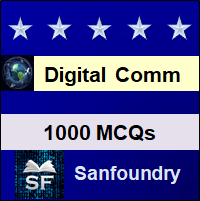
Digital Communications Multiple Choice Questions Highlights
- 1000+ Multiple Choice Questions & Answers (MCQs) in Digital Communications with a detailed explanation of every question.- These MCQs cover theoretical concepts, true-false(T/F) statements, fill-in-the-blanks and match the following style statements.
- These MCQs also cover numericals as well as diagram oriented MCQs.
- These MCQs are organized chapterwise and each Chapter is futher organized topicwise.
- Every MCQ set focuses on a specific topic of a given Chapter in Digital Communications Subject.
Who should Practice Digital Communications MCQs?
– Students who are preparing for college tests and exams such as mid-term tests and semester tests on Digital Communications.- Students who are preparing for Online/Offline Tests/Contests in Digital Communications.
– Students who wish to sharpen their knowledge of Digital Communications Subject.
- Anyone preparing for Aptitude test in Digital Communications.
- Anyone preparing for interviews (campus/off-campus interviews, walk-in interview and company interviews).
- Anyone preparing for entrance examinations and other competitive examinations.
- All - Experienced, Freshers and College / School Students.
Digital Communications Chapters
Here's the list of chapters on the "Digital Communications" subject covering 100+ topics. You can practice the MCQs chapter by chapter starting from the 1st chapter or you can jump to any chapter of your choice.- Signals and Spectra
- Formatting and Baseband Modulation
- Baseband Demodulation and Detection
- Bandpass Modulation and Detection
- Communication Link Analysis
- Channel Coding
- Modulation and Coding Trade-off
- Synchronization
- Multiplexing and Multiple Access
- Spread Spectrum Techniques
- Encryption and Decryption
- Fading Channels
- Digital Communication
- Error Detection & Channel Coding
- Source Coding
1. Signals and Spectra
The section contains multiple choice questions and answers on various aspects of signals and spectra which include signal classification, digital communication signal processing, autocorrelation, concepts of noise, process types and information on baseband systems.
2. Formatting and Baseband Modulation
The section contains questions and answers on analog signals and its formatting, corruption sources, quantization models, pulse code modulation, baseband transmissions, sampling models and correlative models.
3. Baseband Demodulation and Detection
The section contains MCQs on signals, concepts and types of noises, inter symbol interference, concepts of equalization and non-coherent detection.
|
|
|
4. Bandpass Modulation and Detection
The section contains multiple choice questions and answers on various concepts of digital bandpass modulation, coherent detection and signalling and performance measurement and parameters.
|
|
|
5. Communication Link Analysis
The section contains questions and answers on techniques underlying the analysis of link budget, error control policies related to the analysis of link budget and noise parameters.
|
|
|
6. Channel Coding
The section contains MCQs on waveform coding, sampling concepts that include error detection and correction, structured sequences, encoding and decoding using convolutional methods, convolution codes, reed-solomon codes, interleaving codes, concatenated codes, turbo codes, various convolution theorems and sampling techniques.
7. Modulation and Coding Trade-off
The section contains multiple choice questions and answers on bandwidth efficiency, bandwidth modulation, digital communication system evaluation techniques, trellis coded modulation, amplifier techniques and entropy concepts.
|
|
|
8. Synchronization
The section contains questions and answers on receiver synchronization and network synchronization concepts.
|
|
|
9. Multiplexing and Multiple Access
The section contains MCQs on spread spectrum, LAN techniques and algorithms, INTELSAT, TDM, FDM, their similarities and differences and code division multiple access techniques.
|
|
|
10. Spread Spectrum Techniques
The section contains multiple choice questions and answers on pseudo noise sequencing, jamming, frequency hopping, tracking and acquisition techniques, cellular and cipher systems and their secrecy, stream encryption and spread spectrum techniques.
|
|
|
11. Encryption and Decryption
The section contains questions and answers on concepts of public key cryptography and pretty good privacy policies.
|
|
|
12. Fading Channels
The section contains MCQs on signal time spreading, mobile radio propagation, diversity techniques, diversity techniques, rake receivers, fading effects and decision theory techniques.
|
|
|
13. Digital Communication
The section contains multiple choice questions and answers on abstraction techniques, layering techniques, protocols, random processes and interfaces.
|
|
|
14. Error Detection & Channel Coding
The section contains questions and answers on coding techniques, error detection and correction techniques, interpolation techniques and information coding techniques.
|
|
|
15. Source Coding
The section contains MCQs on quantization techniques.
|
|
|
Wish you the best in your endeavor to learn and master Digital Communications!
